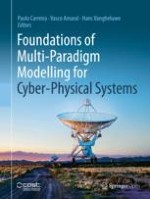Open Access 2020 | Open Access | Buch

Foundations of Multi-Paradigm Modelling for Cyber-Physical Systems
herausgegeben von: Prof. Paulo Carreira, Ph.D. Vasco Amaral, Ph.D. Hans Vangheluwe
Open Access 2020 | Open Access | Buch

herausgegeben von: Prof. Paulo Carreira, Ph.D. Vasco Amaral, Ph.D. Hans Vangheluwe
This open access book coherently gathers well-founded information on the fundamentals of and formalisms for modelling cyber-physical systems (CPS). Highlighting the cross-disciplinary nature of CPS modelling, it also serves as a bridge for anyone entering CPS from related areas of computer science or engineering.
Truly complex, engineered systems—known as cyber-physical systems—that integrate physical, software, and network aspects are now on the rise. However, there is no unifying theory nor systematic design methods, techniques or tools for these systems. Individual (mechanical, electrical, network or software) engineering disciplines only offer partial solutions. A technique known as Multi-Paradigm Modelling has recently emerged suggesting to model every part and aspect of a system explicitly, at the most appropriate level(s) of abstraction, using the most appropriate modelling formalism(s), and then weaving the results together to form a representation of the system. If properly applied, it enables, among other global aspects, performance analysis, exhaustive simulation, and verification.
This book is the first systematic attempt to bring together these formalisms for anyone starting in the field of CPS who seeks solid modelling foundations and a comprehensive introduction to the distinct existing techniques that are multi-paradigmatic. Though chiefly intended for master and post-graduate level students in computer science and engineering, it can also be used as a reference text for practitioners.